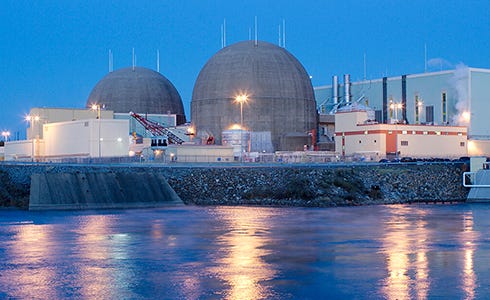Author: Jeff Luse
For much of the latter half of the 20th century, the United States was a global leader in developing nuclear power. Vast buildout of nuclear operations came to a halt in the wake of the meltdowns at Three Mile Island in 1979 and Chernobyl in 1986, however, sparking an anti-nuclear movement that led politicians, activist groups, and the general public to go so far as to endorse coal over carbon-free nuclear power.
Public sentiment has recently changed as the need to deliver reliable, carbon-free energy to the grid becomes increasingly urgent. Governments and the private sector are investing billions of dollars into advanced technologies and existing nuclear power plants.
Across the nation, state legislatures have introduced over 50 pieces of legislation to advance nuclear power within their respective borders. The topics of these bills, which have been predominantly introduced by Republicans (although bipartisan support is rising), range from conducting feasibility studies for advanced nuclear power to lifting state-wide moratoriums on new nuclear power development.
While these investments and legislative advancements are happening in nuclear-heavy regions such as Georgia and Pennsylvania, several other states that have historically hesitated to use nuclear power are accelerating its deployment.
Three states are taking impressive steps to advance nuclear power in their legislatures.

Virginia
Virginia is a hub for innovation with its world-class universities, diverse economy, and leading research facilities. As a result, the Commonwealth has often set an example for policies and initiatives to advance all energy sources. In October, Governor Glenn Youngkin (R) announced that he would propose $10 million in the upcoming budget for a Virginia Power Innovation Fund to accelerate next-generation energy technologies –including nuclear energy.
Last month, Virginia’s state legislature passed HB2386, which created the Virginia Power Innovation Fund and Program. Money appropriated for the fund will be used exclusively for research and development for nuclear power, hydrogen, energy storage, and carbon capture and utilization. The law also created a nuclear innovation hub program that will competitively award funding for deploying advanced nuclear reactor technologies, fund workforce development, and provide grants to support higher education in the space of nuclear energy and advanced nuclear technologies.
In addition to HB2386, the Virginia House of Delegates has advanced three pieces of legislation that define advanced nuclear energy as “renewable” under the state’s renewable energy portfolio program, establish a pilot program for small modular reactors, and set cost-sharing agreements for advanced nuclear power plants with certain localities.
All four bills will be impactful in reducing the carbon footprint of Virginia’s energy portfolio while providing reliable power to consumers. Currently, 57% of Virginia’s power generation comprises natural gas, while nuclear power and renewables are responsible for 30% and 9% of generation, respectively.
Arkansas
While Arkansas has one nuclear power plant, Arkansas Nuclear One, it is not traditionally labeled a nuclear power leader. The state has taken steps to advance nuclear fuel technology with HB1142 which will establish the Arkansas Fuel Recycling Program.
Under the program, the Arkansas Department of Energy and Environment will conduct a study to measure the commercial viability of recycling spent nuclear fuel in the state, the cost to build a fuel recycling facility, and the market value of recycled spent fuel. The University of Arkansas would conduct hearings and public outreach initiatives to determine the best place to site an interim spent fuel repository and fuel recycling facility. The university will also develop a nuclear science and engineering program to “provide future generations of nuclear engineers to capitalize on future opportunities available at the spent nuclear interim storage and recycling facility.”
HB1142 has recently been signed into law by Governor Huckabee Sanders.

West Virginia
In 2021 West Virginia was the second leading coal-producing state, behind only Wyoming. That same year, the Mountaineer state was the country’s fourth-leading natural gas producer. West Virginia is taking steps to advance nuclear energy despite its fossil fuel reliance. In 2022, the state’s legislature voted overwhelmingly to strike down West Virginia’s ban on new nuclear power enacted in 1996.
Continuing its nuclear energy progress, state lawmakers passed a joint resolution this year that directs Marshall University and West Virginia University to lead a consortium that will help the legislature develop policies and programs to facilitate nuclear energy developments in the state. The consortium will also work with universities and businesses in other states to advance public-private partnerships to accelerate nuclear power.
Additionally, legislation advancing would allow West Virginia to become an Agreement State with the Nuclear Regulatory Commission (NRC). Agreement States regulate radiation standards and low-level waste disposal within their borders rather than through the NRC. Becoming an Agreement State reduces the red tape and bureaucracy often a part of the regulatory process for nuclear power, allowing projects to be licensed and deployed quicker.
The anti-nuclear energy sentiment of the 1990s is beginning to be phased out as the U.S. recognizes the need to deploy carbon-free energy to the grid. Several states in the country, many of which are not traditionally thought of as clean energy leaders, are taking steps to reduce regulatory barriers for nuclear power and advance next-generation technologies. This is good news for consumers and the climate.
Read more blogs:
https://www.generationatomic.org/blog/



